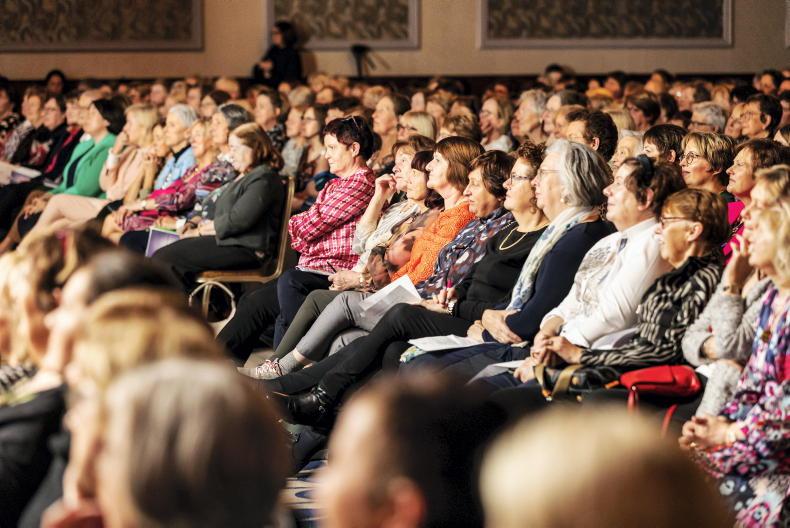When the Irish Farmers Journal recently sat down for a parting interview with then Glanbia plc Group managing director Siobhán Talbot, she said that it is important for women entering the industry to be able to have female leaders to look up to.
“If you can see it, you can be it,” she said.
Right now across the Irish dairy industry, it is very difficult for any aspiring young woman to see very much at all. Women continue to have next to zero representation on dairy co-operative boards across the country, and the situation has only very slightly changed in recent years.
Back in 2017, the Irish Farmers Journal looked at the major processors and found that of 97 board members across Arrabawn, Aurivo, Dairygold, Glanbia (now Tirlán), Lakeland, Tipperary, and Carbery, there was only one woman. Doing the same analysis today based off most recent financial reports, we see that the number of board members has increased to 98 and the number of women on those boards has increased to three (see Figure 1). To put it another way, there are the same number of people called William on the board of Tippery Co-op, as there are women on boards of all the main dairy co-ops in the country.
This almost comically bad representation has not gone unnoticed, with the Irish Co-operative Organisation Society (ICOS) launching a gender equality charter in March of last year, with the aim of altering the “abject imbalance” in the co-op sector.
The all-male board of ICOS launched the charter, which aims to “identify, support and promote female candidates who can be available for election or selection for all leadership roles in the sector”.
The charter acknowledges that the root of the poor participation of women in co-operative structures is a direct result of the low number of female co-operative members. It says that ICOS co-operatives will seek to address this by actively encouraging “male shareholders to add the names of their partners, where appropriate, as joint shareholders on the co-operative share register”.
Several co-operatives the Irish Farmers Journal spoke to are already implementing this measure.
On the executive side of the dairy processing business, things only look slightly better.
Arrabawn, Tipperary and Lakeland have no women on their executive teams. Tirlán has one in a team of eight, Carbery has one woman on its seven-member leadership team, Dairygold has three women in their 10 senior roles, and Aurivo has three on its nine-strong executive. Together, that is a total of eight female executives in 46 roles across the co-operatives listed, or just over 17% of the total.
Disappointingly, there are no women CEOs in any of those companies.
In fact, the last year has been a one of set backs rather than progress for female representation at the very top across the sector. The retirement of Siobhán Talbot almost serves to highlight the lack of progress in this area. Now that she is gone, the number of dairy CEOs falls back to zero.
This is not just an issue with co-ops. Last year also saw the announcement that Zoe Kavanagh would be stepping down from her role as CEO of the National Dairy Council. Looking even further afield, Margaret Sweeney’s retirement from Irish Real Estate Investment Trust means that Ireland will soon be in a position of having no female CEO of a publicly listed company.
The one place that obvious progress has been made is in appointments to State boards, specifically boards connected to the Department of Agriculture. On the occasion of St Brigid’s Day last year, Minister for Agriculture Charlie McConalogue warned that he would refuse male candidates for State boards which have not done enough to address gender imbalance. Bord Bia now has five female board members, with each of the three appointments in 2023 being a woman. Bord Iascaigh Mhara’s board is now 60% female. The board of the newly created agri-food regulator has a 50-50 gender split. Coillte has both a female CEO in Imelda Hurley and a 50-50 gender balance.
The Veterinary Council of Ireland’s board is 47% female, with Teagasc at 36%. In fact, only two boards under the Department of Agriculture have less than 30% female representation. The Sea-Fisheries Protection Authority three-member board are all men, while the National Milk Agency’s 14-member board only has two women – a function of much of that board being producer and processor representatives.
Comment
We at the Irish Farmers Journal have regular conversations with leadership in the Irish dairy industry and, it has to be said, there certainly has been an increase in awareness of the gender diversity failures in the sector in recent years. However, it seems that those words are very slow in being turned into action. With the number of female board members rising by two in five years at the co-ops we looked at, it would take until the year 2142 to achieve gender balance.
On the other hand, Minister McConalogue seems to have been as good as his word when it comes to appointments to State boards, with significant improvements there recently. This shows, in some ways, that all that is required for increased female representation is for someone in power to insist on it.
The ICOS charter published a year ago is a decent roadmap for what can be done to kick start the long-overdue rebalancing of co-op boards.
However, the thing about roadmaps is that they are only actually any good if someone chooses to follow them.






 This is a subscriber-only article
This is a subscriber-only article











SHARING OPTIONS: